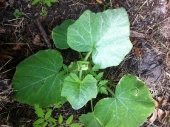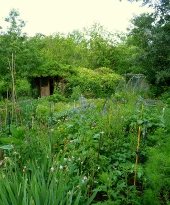I have discovered tiny white worms in two places. The first place was in a large pile of woodchip - shredded fresh a few months ago and left untouched except for the chickens scratching around in it. Then the chickens were gone for a month and the pile had lots of rain. When I came back I dug out a scoop and discovered tiny white grubs, 1cm or less long, and very thin. they looked like grubs but they might have been worms.
The chickens did have worms at one point in the fall, I cleaned out their coop thoroughly, disposed of the bedding far away, dusted everything with DE, and have not had any obvious reoccurence of worms. I don't think the grubs are the same as what I saw in the
chicken coop but I can't be 100% sure. The chickens free range over a very large area.
Then yesterday I went to check on my '
lasagna' bed - last August I piled up 12" of woodchip, 8-12" of semi-composted cow muck (cow poop mixed with straw), topped it with 12" of dried hay. It's been out in the rain since then untouched. When I dug into it I discovered these white worms in the cow muck layer - but impossible to tell if they came from the cow muck or the woodchip. I'm not 100% sure these are the same as the ones in the woodchip pile, as these looked more like worms and less like grubs - these are 1-2cm long and very thin and wriggly. They are totally white. This bed has not decomposed as much as I would have hoped - all the elements are still indentifiable. But it also has plenty of nice fat, healthy-looking earthworms in it. I think mostly earthworms, not red wrigglers, although I have plenty of those in my garden
compost heap.
So, does anyone have a clue about this white grubs and/or worms? Should I panic - are they horrible parasites and having them near my chickens, compost, and vegetable garden going to make me terribly ill? Or are they juvenile earthworms? Or something else? Help!









